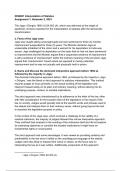Other
IOS2601 Interpretation of Statutes Assignment 1 Semester 2 2023
- Course
- Institution
The document provides a model answer to IOS2601 Assignment 1 Semester 2 2023. The assignment was based on the Jaga v Dönges 1950 (4) SA 653 (A), which was delivered at the height of apartheid, remains important for the interpretation of statutes after the democratic transformation.
[Show more]





